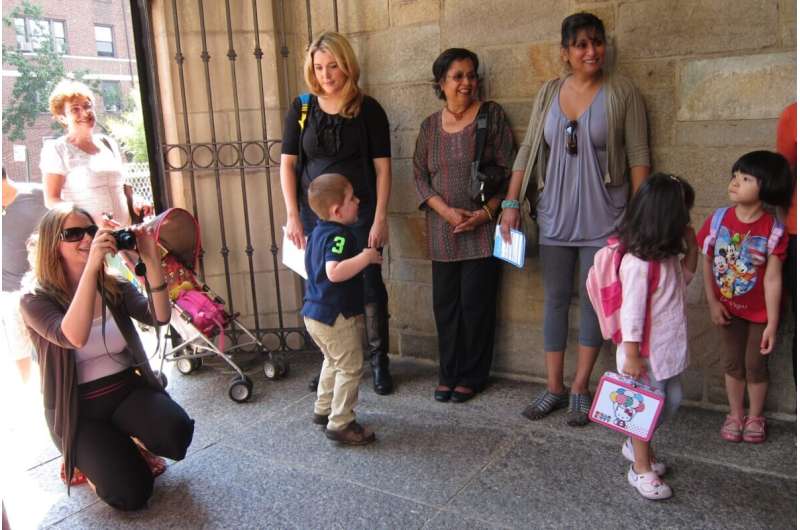Racial demographics influence school choices for white, Asian and Latino parents, finds study of NYC school preferences

White, Asian and Latino parents in New York City all express strong racial/ethnic preferences in where to send their kids to high school, according to a study just published in Sociology of Education. The study suggests that these preferences contribute substantially to school segregation in New York, which has one of the most racially segregated school systems in the country.
“Part of what’s going on is white parents living in a diverse city who don’t send their kids to Black neighborhood schools,” said study author Chantal Hailey, an assistant professor of sociology at The University of Texas at Austin. “But the choices and preferences of non-white parents also contribute to school racial and ethnic segregation.”
In order to tease out the role that racial/ethnic demographics play in parental preferences, Hailey conducted an experiment with a racially diverse group of 1,000 parents and students attending New York high school fairs. Families were asked to rank their preferences for a variety of hypothetical high schools. The school profiles included information on safety ratings, metal detector presence, graduation rates and extracurricular activities.
The profiles also included, but did not highlight, information about the racial/ethnic demographics of the schools. The goal, said Hailey, was to discern how large a role the racial/ethnic information played when families were selecting among otherwise similar schools.
She found that when white, Asian and Latino parents were presented with the choice of otherwise similar schools that were majority Black, majority white, majority Latino or mixed, the racial/ethnic demographics directly influenced their preferences.
White parents rated the hypothetical majority white school highest, followed by the mixed school, then the majority Latino and Black schools. Asian parents, like their white peers, were also less willing to attend the majority Latino and Black schools. Latino parents preferred the majority Latino school, and most wanted to avoid the majority Black school. Black parents showed no statistically significant preference for any of the schools based on racial/ethnic composition.
The results of Hailey’s experiment were consistent with the real-world administrative data on family preference in the New York high schools. Controlling for numerous other school characteristics, white families were 97% less likely to rank majority Black schools first on their applications compared with majority white schools, and 84% less likely to rank majority Latino schools first. Asian families were 90% less likely to rank majority Black schools first and 45% less likely to rank majority Latino schools first. And Latino families were 67% less likely to rank majority Black schools first on their applications compared with majority Latino schools.
“All racial groups tend to report feeling closer to their racial in-group, so that likely drives some of the preference,” said Hailey. “But it is more complicated than that. People also draw on stereotypes about racial out-groups that are perpetuated in our education system, in particular negative stereotypes about Black students. There is also evidence that parents associate white schools with more resources, and Black and Latino schools with fewer. Those race-based stereotypes may drive preferences even when there’s data suggesting that there’s no actual disparity in resources.”
Hailey’s study also queried eighth grade students to see whether their racial/ethnic preferences aligned with or diverged from their parents’. She found that there were substantial differences, particularly in the degree of aversion to the majority Black school.
White students, for instance, preferred the majority white school but were half as averse to the majority Black school as their parents. White eighth graders also did not distinguish between their preferences for the majority Latino, majority Black and mixed schools.
Latino parents and their children preferred the majority Latino school, but the parents rated the majority Black school as least desirable. Their kids did not distinguish between their willingness to attend the majority white, majority Black and mixed schools.
Black parents did not show any strong preference for schools by their racial/ethnic composition. Black students, on the other hand, expressed less willingness to attend the majority white school compared with the majority Black, mixed, and majority Latino schools.
There were no statistically significant differences between Asian parents’ and students’ school preferences based on their racial/ethnic composition.
White flight may still enforce segregation
Chantal A. Hailey, Racial Preferences for Schools: Evidence from an Experiment with White, Black, Latinx, and Asian Parents and Students, Sociology of Education (2021). DOI: 10.1177/00380407211065179
Citation:
Racial demographics influence school choices for white, Asian and Latino parents, finds study of NYC school preferences (2022, January 7)
retrieved 7 January 2022
from https://phys.org/news/2022-01-racial-demographics-school-choices-white.html
This document is subject to copyright. Apart from any fair dealing for the purpose of private study or research, no
part may be reproduced without the written permission. The content is provided for information purposes only.
For all the latest Science News Click Here
For the latest news and updates, follow us on Google News.

